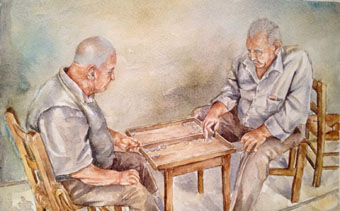|
| Magriel's NYT Columns |
 Every game of backgammon is ultimately a race, and so “high dice” are generally favorable. There are times, however, when moving forward quickly is not advantageous. It may be necessary, for example, to maintain a certain defensive structure for several rolls. In such a case one hopes to advance as slowly as possible.
Every game of backgammon is ultimately a race, and so “high dice” are generally favorable. There are times, however, when moving forward quickly is not advantageous. It may be necessary, for example, to maintain a certain defensive structure for several rolls. In such a case one hopes to advance as slowly as possible.
Many players believe there is no way to control the rate of progress, and so feel entirely at the mercy of the dice. But a technique does exist that enables a player to slow himself down.
In the diagrammed position, there is an opportunity for Black to use this technique. Black has already been doubled and is now in an unenviable situation: With three men securely trapped behind White’s 6-point prime, he must wait passively for White to bring his back men around.
|
| Black to play 2-2. |
The obvious play is not correct because it fails to take into account when White will leave a shot. White may not leave a shot at all, and if he does, it will not be immediately. It will most likely come at least four rolls later — after White has brought his spare men home. According, Black must plan to have a good board in four rolls — not now.
Consider what will happen in the next four or five rolls. Black will be forced to continue moving forward. As he rolls, Black may be forced to stack almost all his men on the 1-, 2-, and 3-points. With these men permanently out of play, his position will be irrevocably damaged. The Black would have no hopes of winning, even if he hit White later.
Black wants to avoid having his position crumble. Indeed, Black would like to “freeze the position,” and not move forward at all. This is impossible. Nevertheless, it is possible for Black to slow himself down.
Black can slow his progress by making it impossible for him to play certain numbers. The correct play is bar/23, 7/5, 6/2. This play removes men from the 7- and 6-points. As a result, Black no longer has either a legal 6 or a legal 5 to play. This technique is called “depriving yourself of numbers.” By slowing himself down in this fashion, Black gives himself the best chance to preserve a good home board several rolls hence.
Rollout
 Tom Keith 2013 |
|
Money play Black owns 2-cube Black rolls 2-2 1296 games with VR Checker play: 2-ply Cube play: 3-ply Red |
| 2-2: | Game | G | BG | Equity | ||||
| 1 | bar/23, 7/5, 6/2 |
W L |
.0816 .9184 |
.0020 .1500 |
.0000 .0033 | −0.9587 |

| (b) |
| 2 | bar/23, 7/3, 6/4 |
W L |
.0802 .9198 |
.0019 .1502 |
.0000 .0033 | −0.9632 | (0.0045) | |
| 3 | bar/23, 7/1 |
W L |
.0787 .9213 |
.0016 .1529 |
.0000 .0036 | −0.9690 | (0.0103) | |
| 6 | bar/23, 5/1, 4/2 |
W L |
.0754 .9246 |
.0015 .1551 |
.0000 .0035 | −0.9791 | (0.0204) | (a) |

|
|

